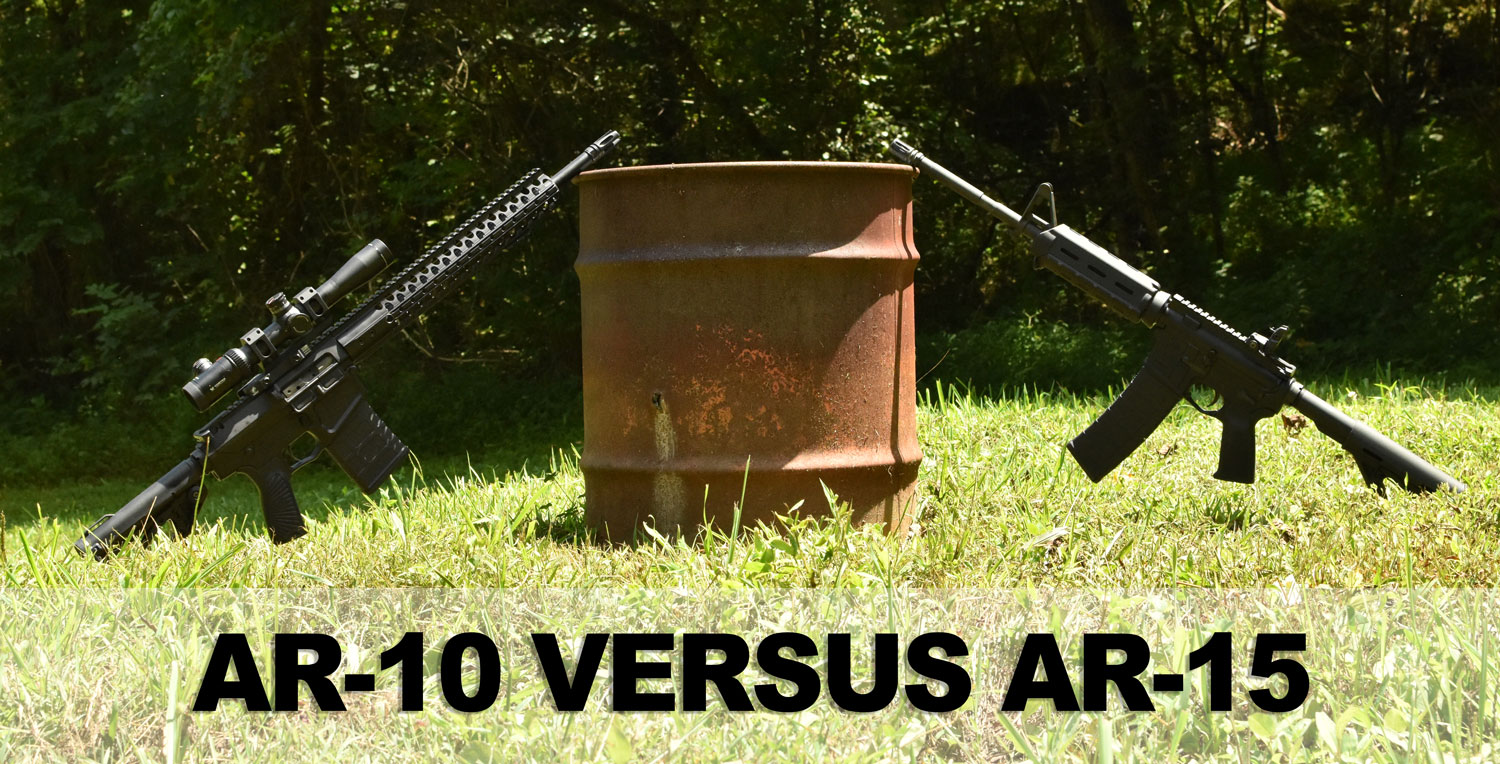Two worthy carbines – the AR-10 vs AR-15 – are among the most popular rifles in the United States. In this guide, we compare the two modern sporting rifles and help you decide which best fits your needs as a shooter.
Maybe the best introduction to the AR-10 vs AR-15 debate is an oft-cited joke that goes something like this.
“If you’re afraid of an AR-15, get an AR-10. That’s five fewer ARs.”
This joke is pretty funny if you know anything about these often misunderstood modern sporting rifles. Mass panic over “assault rifles” have made most people at least moderately aware of the AR-15 (As a side note, AR stands for “Armalite rifle,” not “assault rifle.”)
However, few people outside of shooting culture truly understand the weapon. Fewer still can tell you the difference between an AR-15 and an AR-10.
AR-10 vs AR-15 – Quick Look
In short, Armalite designed AR-10 rifles to fire 7.62×51 ammo. They made the AR-15 to fire .223/5.56 ammunition. The AR-10 is slightly bigger (more powerful) while the AR-15 is lighter and allows most shooters to carry more rounds of ammo.
Of course, there are a bunch of other details we’re happy to dive into. Knowledge is power, so we’re going to take a look at the history of these two popular firearms. We’re also going to explore their similarities and differences. Hopefully, this article will help you better understand what separates an AR-10 from an AR-15, as well as why you might choose one over the other.
Maybe with a little education, we can help shake the bad reputation unfairly stuck to these popular and useful firearms in this AR-10 vs AR-15 guide.
The Birth of the Armalite Rifle
As you might have guessed, the AR-10 and AR-15 share an Armalite family tree. Armalite was established in 1954 as a subdivision of Fairchild Engine and Airplane Corporation.
The AR-1, the oldest child of the Armalite line, was originally developed as a weapon for paratroopers. Lightweight and short-barreled, the AR-1 was perfect for soldiers jumping out of perfectly good airplanes. Several other AR weapons followed, including the AR-7 survival rifle still in production today.
In the mid-1950s, former Marine and Army Ordinance technician, Eugene Stoner joined the Armalite team. Stoner is responsible for developing the original AR-10. Chambered in 7.62x51mm, the AR-10 had a lightweight receiver and integrated carrying handle.
However, the major development was the direct impingement system which pipes exhaust gases directly into the receiver, which then cycles the bolt carrier. This simplified design reduces the overall weight of the AR-10 compared to rifles using popular gas piston technology.
Armalite submitted this new design to the United States government as a candidate for replacement of the M1 Garand. Ultimately, the AR-10 lost to Springfield Armory’s T44, an updated M1 Garand design that would later become the M14. Now, you can find AR-10 rifles chambered in a number of different calibers.
The jungles of Vietnam completely changed modern warfare. As the new M14s were pitted against enemy AK-47s, soldiers on the frontlines regularly reported problems controlling their M14s in fire mode. Another major concern was ammunition for the M14 was too heavy. The extra weight prevented American forces from carrying enough ammo to gain fire superiority over enemies equipped with the smaller 7.62x39mm cartridges used to load their AK-47s.
In an attempt to overcome these difficulties, Army officials asked Armalite to develop a smaller version of their AR-10. The specific request was for a weapon chambered for the newly developed and much lighter 5.56mm NATO rounds.
The AR-15 Enters the Scene

The new AR-15 design was submitted for testing by the U.S. Continental Army Command. These lightweight rifles were meant to replace the Browning Automatic Rifle, M1 Garand, M1 Carbine, Thompson Submachine Gun, and M3 “Grease Gun” all in one fell swoop.
Despite performing well in every possible test category, Army Chief of Staff General Maxwell Taylor chose the M14 over the AR-15.
In response to this major setback, Armalite sold the designs of both the AR-10 and AR-15 to Colt Manufacturing Company in 1959. Colt immediately prepared the AR-15 for mass production, something that certainly saved the design from landing at the bottom of the firearms trash bin.
The AR-15 Gains Popularity
In 1960, the AR-15 gained its first high-ranking military advocate. At a Fourth of July party, Air Force Vice Chief of Staff General Curtis LeMay was invited to pluck watermelons off fence posts with an AR-15. He was instantly a fan. Duly impressed with the weapon’s accuracy and small weight, General Lemay ordered 8,500 AR-15s. This first order of AR-15s went to Air Force pilots and were intended to provide a fighting option in the event of being shot down over enemy territory.
In 1961, General Lemay (newly promoted to USAF Chief of Staff) ordered an additional 80,000 AR-15s for his airmen. He contended the lighter recoil and smaller caliber were more effective than the somewhat cumbersome M14.

The AR-15 Versus the M14
While common sense should have made the AR-15 a shoe-in for replacing the M14, high level military officials are not always known for their common sense. General Maxwell Taylor, Chair of the Joint Chiefs of Staff, vetoed military use of the AR-15. His reasoning was that the military could not have two rifles chambered for different rounds in service simultaneously.
Meanwhile, the AK-47 continued to dominate the M14 in Vietnam. However, U.S. Army Special Forces in theater managed to get their hands on the lightweight, easy-to-shoot AR-15. In positive reviews sent back to military command, these units praised the rifle’s combat effectiveness.
Due to the positive reports from Special Forces, Secretary of Defense Robert McNamara ordered in-depth testing of the AR-15, AK-47, and M14. Surprisingly, reported results favored the M14. Since this didn’t seem possible considering first-hand accounts of the weapon’s performance on the battlefield, Secretary of Defense McNamara ordered an investigation of testing procedures. This investigation discovered the tests were grossly biased toward the M14.
One outrageous example of the unfair slant provided the M14 occurred during accuracy tests, which pitted the M14 in semi-automatic against a fully automatic AR-15. I’m no conspiracy theorist, but this makes me wonder who was lining the pockets of high ranking military officials to keep the M14 in the hands of our servicemen. It does no good to speculate how many American lives may have been spared if the AR-15 had been adopted earlier in the conflict.
Thankfully, in 1963, the Department of Defense was informed the production of M14s could not keep up with military demands. Colt stepped in with its massive manufacturing capabilities, and all branches of the US military were supplied with AR-15 rifles. These rifles would later be re-designated as M16s.
What’s the Difference Between the AR-10 vs AR-15

The AR-10 and AR-15 are nearly identical weapons. Mechanically, they both use a direct impingement gas system.
The AR-10 and AR-15 both use a rotating bolt design.
Both rifles use the same trigger group.
Both are lightweight and produce relatively light recoil.
So, what separates an AR-10 vs AR-15?
The most significant difference between these two rifles is the caliber. The AR-10 was originally chambered in 7.62×51 NATO, while the AR-15 was originally designed for 5.56mm cartridges.
Today, these rifles are available in a variety of chamberings. You can find AR-10s chambered for longer action cartridges like the popular 6.5 Creedmoor, 6.5x47mm Lapua, and .243 Winchester. However, most AR-10s are still chambered in 7.62×51 NATO/.308 Winchester.
Although the AR-15 is still most commonly chambered in 5.56mm/.223 Remington, they are also available for a long list of short action centerfire cartridges, including .300 AAC Blackout and the new .224 Valkyrie.
While the main design is the same, the difference in caliber offerings also manifest in a few minor differences between the AR-10 and AR-15. The main differences are in rifling and ballistics. However, the AR-10’s heftier ammunition make it naturally heavier than the standard AR-15 (by about a pound and a half on average). The weightier ammo also limits magazine capacity. The AR-10 typically has a 25-round capacity compared to the AR-15’s 30 rounds.
Why Choose an AR-10?
The AR-10 really excels in long distance shooting. With heavier ammunition and a flatter trajectory, the AR-10 has a longer effective range (somewhere between 600 and 1,000 yards, depending on the proficiency of the shooter).
For long-range target shooting, the AR-10 is a far better choice than the AR-15. Its serious long-range capability also makes the AR-10 a favorite of law enforcement snipers.
While the AR-10 may push its heavier projectile a bit slower than the AR-15, that .308 caliber bullet packs a wallop once it gets there. This makes the AR-10 a much better option for hunting, especially when you’re stretching shots across fresh cut bean fields or open prairie. The .308 Winchester is more than capable of dropping any North American game animal (except maybe large bears) as well as most animals roaming the African continent.
Why Choose an AR-15?

This popularity has its advantages. You can walk into any local gun shop or big box sporting goods store and find ammunition for the AR-15. That ammo is also likely to be cheaper than ammo for an AR-10.
Depending on current political currents, you might be able to pick up a few spare mags, after-market accessories, maybe even some spare parts.
Although considered a shorter range weapon than the AR-10, the AR-15 is still highly effective between 300 and 500 yards (depending on the ammunition used and skill of the shooter). .223 rounds can be used to hunt whitetails at close range with careful shot placement. However, some jurisdictions prohibit hunting deer with calibers under .24 inches. This often relegates the AR-15 to predators and varmints, for which it is well-suited.
What the AR-15 lacks in power and range, it more than makes up for in shootability. With a lighter weight and less recoil, the AR-15 is less awkward, especially in close quarters, and offers faster, more accurate follow-up shots. Pair this with its larger 30-round magazine capacity, and the AR-15 allows you to put lead downrange much faster and more effectively than the AR-10. This may be the single most important factor for choosing the AR-15 for military, law enforcement, and home defense applications.
AR-15 vs AR-10 – Are The Parts Interchangeable?
You can interchange some parts of the AR-10 with the AR-15. While the AR-10’s lower receiver and other key components are larger than the AR-15, there are parts you can typically use in both rifles. Please note, this list is meant as a general guide. With at least dozens of manufacturers in the United States right now, it can be tricky to say definitively that parts are interchangeable.
- Hammer Springs and Hammers
- Buttstock Assemblies
- Castle Nut
- Triggers and Trigger Springs
- Trigger Guard Assembly
- Bolt Catch Roll Pin (For Armalite Style rifles only)
- Bolt Catch Spring & Plunger
- Mag Release Buttons & Magazine Release Springs
- Safety Selectors
- Pistol Grips (you may need a spacer), Pistol Screws & Washers
- Receiver Extension or Buffer Tube
- Disconnector and Disconnector Spring
- Buffer Detent
- Takedown Springs & Takedown Detent
- Pivot Springs & Pivot Detent
Final Thoughts on the AR-15 vs AR-10 Debate
Making a choice between these two popular rifles isn’t always cut and dry. If you hunt big game or engage in extreme long range shooting, the AR-10 is the better option. However, the AR-15 is easier to shoot, cheaper to feed, and more than adequate at ranges under 500 yards.
Basically, there is one simple solution. If you have the money, just get one of each. Or more. I’m not one to judge.






